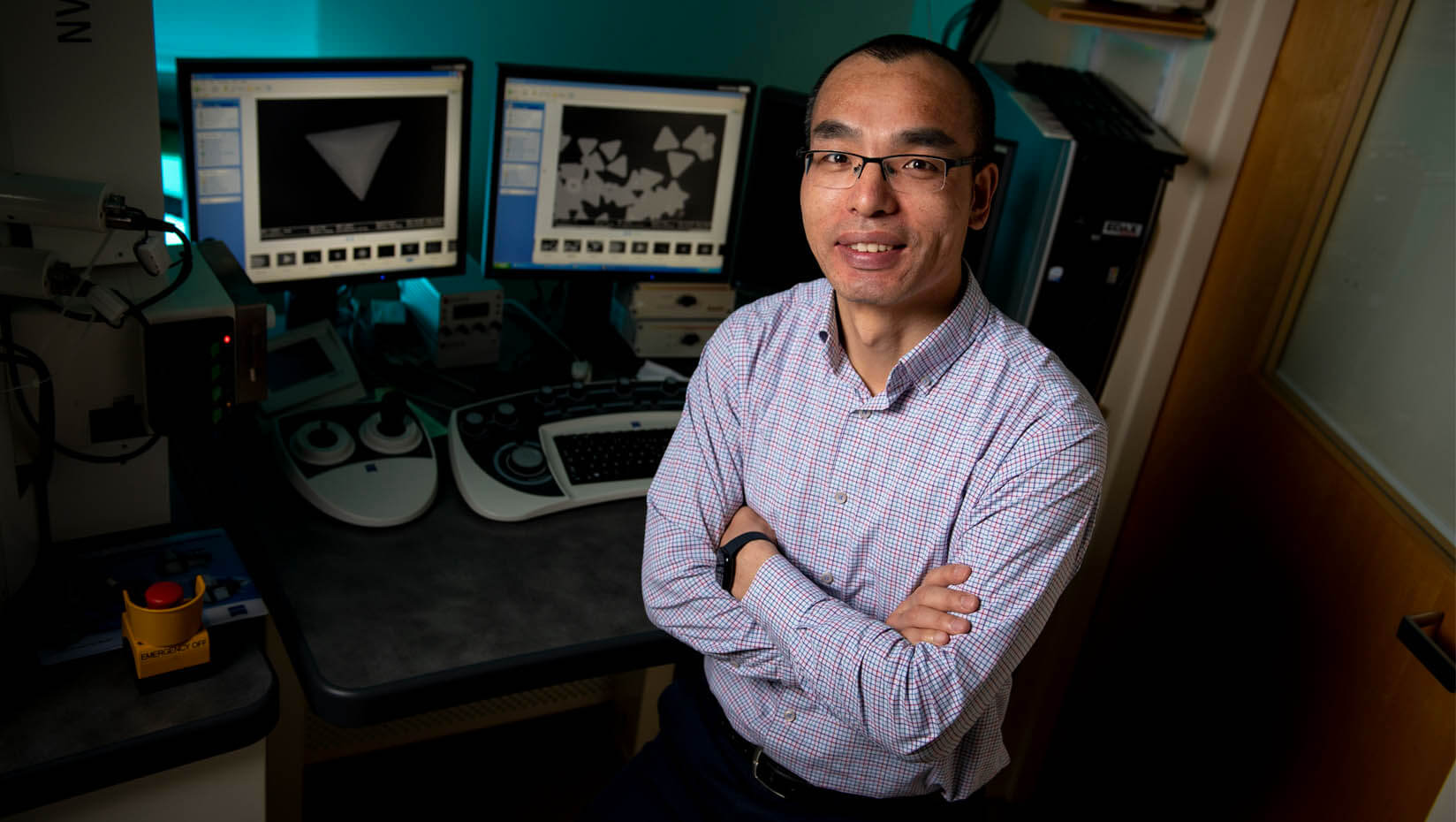
Yang receives NSF Early Career Award for nanomaterials research
Yingchao Yang, assistant professor in the University of Maine Department of Mechanical Engineering, received a National Science Foundation (NSF) Early CAREER Award for his research on asymmetrical fracture of high-entropy two-dimensional nanomaterials.
Yang is the fourth member of the Department of Mechanical Engineering to receive the prestigious award in 2021–22.
Ultrathin two-dimensional (2D) nanomaterials have been extensively researched for use in devices like electronics, photonics, batteries and more. The stability of components made from the materials is critical to their reliability, but toughening the brittle materials — making them more resistant to fractures, for example — often comes at the cost of their mechanical strength. What’s more, 2D high entropy materials (HEMs), nanomaterials that consist of multiple elements, are asymmetrical, and thus harder to fracture.
Yang’s research goal is to study the asymmetrical fractures of 2D HEMs. He will use the NSF funding to pursue four research objectives: fabricating stable 2D HEMs; conducting in situ tensile testing in a scanning electron microscope to visualize the deformation and fracture scenarios of 2D HEMs and their ripple effects understand the various impacts on the materials’ mechanical behaviors; developing and applying a multiscale framework to simulate fracture behaviors of 2D HEMs with focus on crack initiation and crack propagation; and visualizing crack evolutions at the atomic level via in situ tensile testing using transmission electron microscopy.
Currently, the low fracture resistance of 2D materials makes it almost impossible to experimentally visualize crack propagation at atomic level. Yang’s research strives to reveal more detail about the mechanical behaviors of 2D nanomaterials.
“I have been working on fracture of monolayer hexagonal boron nitride (h-BN). The fracture resistance of h-BN is approximately 10 times higher than that of graphene due to asymmetrical fracture at atomic level. After the finding was published in Nature in 2021, I got an idea: why not have more elements in 2D materials to promote the asymmetry? It is the driving force to fabricate 2D HEMs. The new category 2D materials are expected to have the greatest asymmetry, pushing up the potential in toughening 2D materials,” Yang says.
Tougher 2D HEMs can potentially replace or be integrated into existing materials to provide additional mechanical strengthening for devices.
“2D materials are extremely important for 2D electronics and other applications. In addition to fulfilling functions which regular 2D materials have, 2D HEMs make them the ideal for adding tear resistance to mechanical failure to enhance the devices reliability and service life,” Yang says.
Yang also will develop an education module called “Atomic View of Materials” that will be shared with faculty at UMaine and other educators through an open-access website to improve the mechanics and materials education in mechanical engineering and related disciplines. Graduate and undergraduate students — especially underrepresented groups — will be mentored and trained to conduct scientific research throughout the project as well.
The prestigious NSF awards support of early-career faculty and include a federal grant for research and education activities for five consecutive years.
This year, the NSF also awarded Early CAREER Awards to assistant professors of mechanical engineering Babak Hejrati and Qian Xue. Hejrati’s award will be used to establish a framework for helping people with mobility issues — such as older adults with mobility decline and those who have had a stroke — to improve their walking ability using wearable robots. Xue’s research focuses on the hydrodynamic sensing model of seal whiskers.
Assistant professor of mechanical engineering Sheila Edalatpour also received an NSF Early CAREER Award in 2021 for research studying how the emission of heat changes when the materials involved are quantum-sized, or when they are separated by a gap of the same size as one or multiple atoms.
“Benefiting from the strong support from the Department of Mechanical Engineering, the College of Engineering and the University, we junior faculty are able to establish independent research in our own research fields and secure national funds. With these credits above, it would help us and other junior faculty build up confidence and experience to compete for national funds from not only NSF but also other funding agencies. As UMaine has been designated an R1 university, all funding records, publications, and outreach activities would advance the ranking of UMaine,” Yang says.
Contact: Sam Schipani, samantha.schipani@maine.edu
